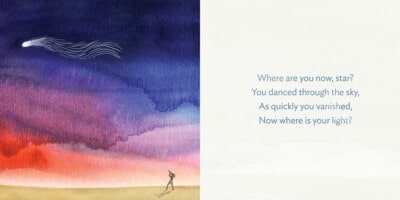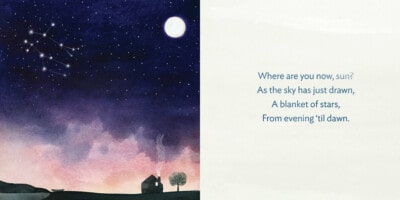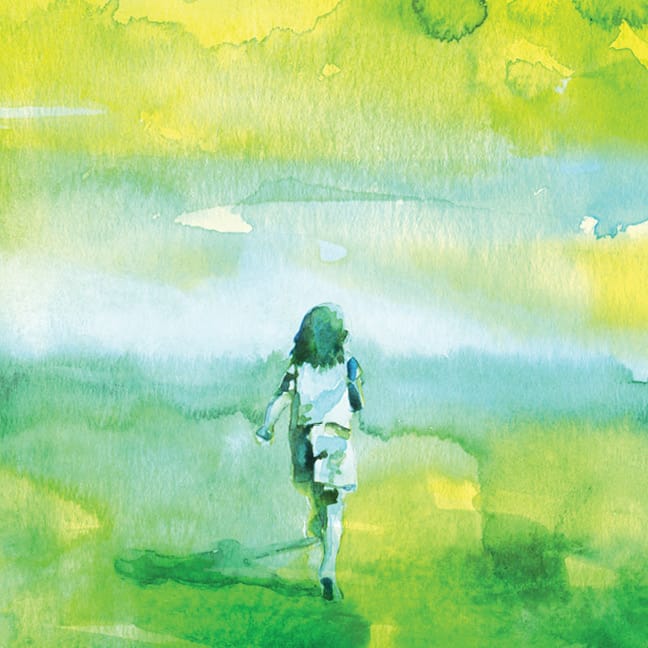Tyler Clark Burke (of Bill Bowerbird and the Unbearable Beak-Ache fame) has a new children’s book: Where Are You Now. With gorgeous watercolour illustrations and a deft touch, Burke tackles one of the most difficult situations we will all have to contend with–that of losing someone we hold dear.
Where Are You Now is a beautiful book about change, death, and transformation. From the disappearance of a shooting star, to the more profound loss of a loved one, Where Are You Now provides a bright and joyful framework to help shape difficult conversations about death with our children.
We asked her about the book this week.

SDTC: Where did the impetus to write ‘Where Are You Now?’ come from?
TCB: I started thinking about my mother in a new way as the tenth anniversary of her death approached.
There were times, previously, when I felt done with grieving, and other times—like when I was pregnant with my daughter—that I felt a deep sadness, even fear, that having a daughter would remind me too poignantly of her absence.
But when ten years rolled up I was surprised by a new string of words that kept intruding on my thoughts:
“She gets to come back now.”
Somewhere my cerebral-heart suddenly thought, “We’ve done our time. The quarantine must finally be over.” It took me a decade to realize that mourning was reactive, and also a process, and that as I move through different phases in life, so will my grief.
The other thought I had—which was a very nice thought—was that my mother was more a part of our lives than I had expected. My daily choices—how I dressed my kids, the cakes I made, the activities I drummed up—were all done to show my kids my mother. This was particularly interesting to me because I was estranged from my mother on-and-off for almost two decades because of her alcoholism, and I was struck by the positive reverberations any life can have (even years later).
Around this time, I also noticed several other friends—and strangers, too—posting messages on Facebook about how to talk to their children about the death of a family member or grandparent. I decided I wanted to make a book for my kids, and theirs, and that I wanted to shine light on the beauty left behind in the wake of death. I also wanted to frame this conversation in nature (and quietly science), without religion or gloom.
How have you approached talking about loss and grief with your own children?
I think one of the more interesting things you learn as a mother of multiple children is how to parent uniquely to each child, and as a result I spoke to my kids very differently about death.
My daughter Rooksby was always the kid running up to, studying, and confronting dead animals with extraordinary curiosity and interest. She was very matter-of-fact in her approach to death, especially when she was little, so we focused more practically on anatomy and how the human body worked (and then why and how it stopped working). Now that she’s older, Rooksby doesn’t like to talk about death or blood at all, even though she continues to contribute to—and maintain—a sometimes startling bone collection on her bookshelf! From Rooksby I learned not to shield my children from death, but to follow their lead and support their interests.
My son Hugo just turned six. He has mourned death—mine, his, everyone’s—since he was about 3. He used to get very sad about dying, but I also think his emotionality allowed him to process death better? I learned with Hugo that I need to frame discussions honestly, but in a way that is also contemplative, circumspect, and comforting. To Hugo I might explain that death is an integral part of life, and it’s important we treasure and enjoy our good days, our good health, our community, and our environment.
How can a picture book make these challenging conversations easier to start?
Kids ask such good questions about words or elements on a page, and so often their curiosity leads to the discussion they need to have. I also think there is something to having, as a parent, a prop to carry in with you in periods of deep mourning or sadness. Death isn’t easy for anyone, and when a family member dies we are often navigating our own grief and puzzling our own uncertainties about life, while also trying to comfort our children.
One of my favorite things someone said about my book was at the tail end of a review: “…[Where Are You Now?] can serve as a quiet bedtime story or a deep conversation starter.” It was really my hope that people would read the book that way—which is really two ways—and I think the metaphorical layering provided by picture books allows for multiple entry points for difficult discussions.

What do you hope that readers take away from this book?
Usually when I approach a picture book I think about the young readers, and their experience of the text, but in this case I was also thinking about the parents. I wanted to write something that would be cathartic, emotional, and uplifting for the adults, to help them experience and understand their grief, too.
When my mother died, we had a week of family dinners, and there was so much laughter and love intermixed with deep sadness. It may be strange to think that one of the best weeks of my life was the one where I cared for—and said goodbye—to my ailing mother, but it’s true. Her death was a beautiful and raw experience. My hope with this book was to bring joy and warmth to readers, but with a little space for unvarnished emotion.
How have your own views of mortality changed since having kids?
One thing I like about being a parent is that you start counting their years and forget your own! Having kids hasn’t entirely shifted my perspective on mortality (although I suppose I worry about theirs now, instead of mine?), but having kids helped quiet my life-long insomnia, anxiety, and the internal focus on just “me”.
An interesting full circle experience was seeing my daughter’s hands for the first time. Her little hands looked and moved just like my mother’s did when she was dying. They both danced their hands through the air, as if tracing currents, or conducting ghosts, then touched their cheek, and forehead, until starting again. Over and over. It was beautiful and electrifying. I’d never seen my mom’s hands move as they did in her final few days, and I’ve never seen Rooksby’s hands move like my mother’s again.
Where Are You Now? Book release PARTY & Irish Wake is coming up next Friday Nov. 22nd at Miss Pippa’s (1158 College St). Get all the info. here.



 Follow Us On Instagram
Follow Us On Instagram
